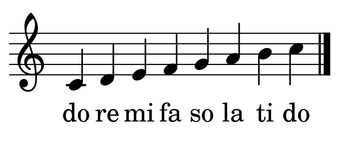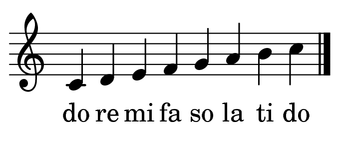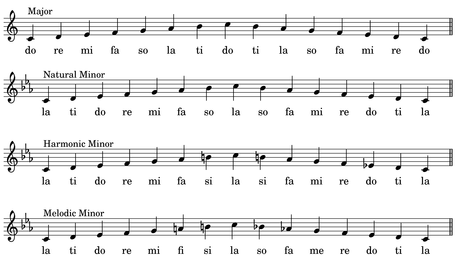In the following articles, we will explore individual topics in ear training in a little more depth. We will develop our study with what I hope is a clear system where each topic builds on the previous one.
With ear training, as with any discipline, it is useful to have a basic methodology or approach in building our skills. We are developing our relative pitch, the ability to discern the distance between notes. We can develop this skill to such a high degree, that we can accurately hear the quality of two or more notes as a kind of color: a major third, is not only bigger than a minor second, it has a different sound quality. Larger collections of notes also have their own sound qualities: a major triad sounds different than a minor one.
In order to discern different types of musical elements like intervals and chords, we need to be able to produce those elements. The first skill we should develop is simply that of matching pitch with our voice. Play the following example and sing back each pitch as you hear it. Its alright if you have to fish around a bit. Now when we are singing, its important for our egos to remember that we are developing our inner ear. The relative goodness or badness of our singing voice is not important. It is more important to simply learn how to match pitch:

Can you sing back each note?
Once we can master the above exercise, we are well on our way. The next skill we should develop is the ability to recognize and sing a major scale.
Since we are starting to sing back more than one note, we need a system to do so. Students typically learn one of three common systems: fixed do, movable do, or a number system. The number system will be familiar to American music students, while Canadian and European students usually use fixed or movable do. I will be using the movable do system here and in the articles that follow since it is the one I am most familiar with, but feel free to substitute another system if it is more familiar to you.
Movable do uses a series of syllables, or solfege, that are easy to sing and represent the different degrees of a major scale. Do always refers to the first scale degree, so to the fifth, as shown below in a C major scale:

Sing a major scale
Listen to the above scale, following along the notes and the solfege syllables. After a few listenings, sing along.
Once you are comfortable singing the above major scale, try listening to it once, then singing it back on your own.
We have begun to establish a system to ear training:
- Listen
- Sing Along
The third step is to sing the desired musical element given a starting pitch. Play a random note at your instrument, then sing a major scale starting on that pitch. Try two or three more scales using different pitches.
Our fourth step is to be able to identify a musical sound once we hear it. In the next example you will hear two different scales. Which one is the major scale?
Pretty neat! You can identify a major scale among a group of other musical ideas.
The first scale in the above example was a natural minor one. As you heard, it has a different sound quality than the major scale. We should learn it the same way as we did the major scale:
- Listen
- Sing Along
- Sing it back given a starting pitch
We can also learn the other scales as well, and start to sing them both ascending and descending. The following example presents the main scales we should study along with their accompanying solfege:
Notice how the solfege syllables are adjusted for accidentals. With sharps, the vowel sound changes to ‘is’: do becomes dis. With flats, the vowel changes to es: mi becomes mes.
If you want a great challenge you could learn to sing a chromatic scale ascending and descending. You will also learn all the solfege syllables:
If the chromatic scale is a little too much for you right now, that’s fine. Focus on major and minor scales for now.
The great part about learning to sing and identify scales, is that learning intervals and chords becomes much easier. Not only do we now have a system in place, but these scales also contain all the intervals and chord types we will be studying.
For example try this exercise: Give yourself a starting pitch and sing the first three scale degrees of a major scale: do re mi. Now sing the re silently: do (re) mi. Now just sing do to mi. You have just sung a major third! We can do the same for a minor third. Sing the first three scale degrees of a minor scale: la ti do. Now sing the ti silently: la (ti) do. And finally sing a minor third: la do. We will further develop this technique for ear training in our next article on intervals.
You can subscribe to our articles to make sure you don’t miss the next Pitch & Harmony lesson. Remember to take things at your own pace, and learn one thing at a time. If you have any questions please leave a comment below, or come ask in the Forums.











I am really seeing some quick improvement in my aural skills thanks to this series, and I think it is mostly due to using the solfege method for the first time. I would really love to be able to hear each of the five scales mentioned in this lesson (i.e., major, natural minor, melodic minor, harmonic minor, and chromatic scale) sung using the solfege syllables. Is there any way you guys can hook that up? This lesson would be so much more effective if you played an audio file of someone singing the scale (using the solfege syllables) after the audio file of the scale being played on the piano. This would really bring it full circle for me.
Hi Clay,
Thanks for your comment – great to hear the series has been helping you in your training!
We're currently working on a downloadable training pack which ties in with this series, and will include plenty of sung examples of solfege. We'll be sending out a message on our mailing list when it's released.
The plan is to come back once that's complete, and add sung examples to the lessons of Pitch & Harmony too.
Christopher
I suppose the total flexibility which gives music its variety and power is also its curse! Hopefully it does at least get easier with practice…?
I am liking the solfege approach. (Don't think I knew it existed outside of "Sound of Music") but not quite sure I understand this statement.:
"Notice how the solfege syllables are adjusted for accidentals. With sharps, the vowel sound changes to ‘is’: do becomes dis. With flats, the vowel changes to es: mi becomes mes."
Perhaps Clay's suggestion of vocal examples would clarify?